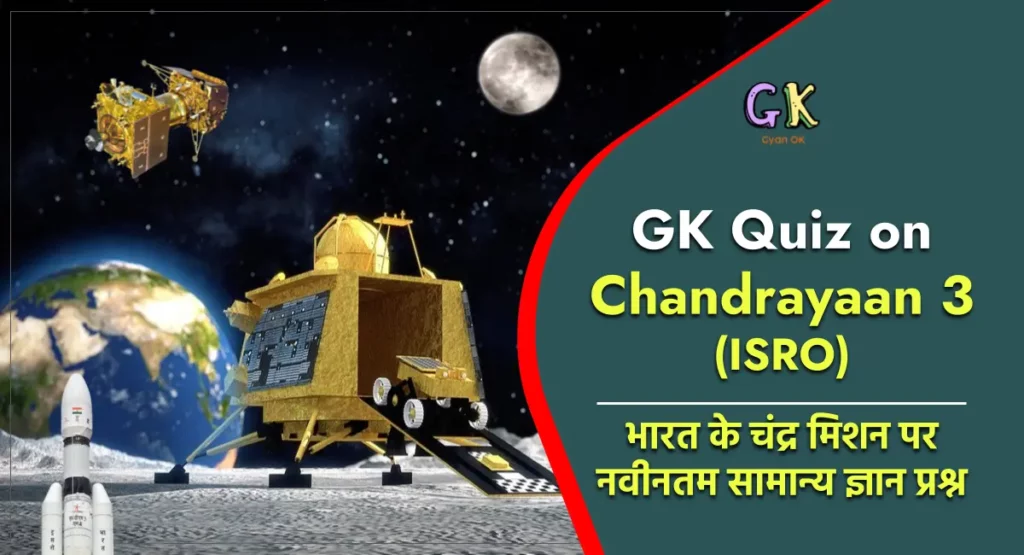India’s achievement of landing its spacecraft on the moon’s south pole is a proud moment, showing what dedication can accomplish. The hearts of every Indian are swelling with pride and joy over achieving such a milestone. This day will be etched in history as a remarkable moment marking a significant step forward in the nation’s space exploration journey.
But taking part in celebrating the victory is just a partial part of learning how much persistence and effort it took for our ISRO team with our vigilant and exceptional scientists. Hence, on this remarkable occurrence, we have prepared a quiz session for all space enthusiasts to access their awareness and learn something new.

General Knowledge Questions and Answers on Chandrayaan 3
Chandrayaan-3, a lunar space mission launched by ISRO (Indian Space Research Organisation) on 14th July 2023, made a successful soft landing on the south pole of the moon on 23rd August 2023, making India the first-ever country to successfully land on the south pole of the moon. Chandrayaan-3 was launched by an LVM3-M4 rocket by the Director of Satish Dhawan Space Centre SHAR from ShriHariKota- Andhra Pradesh it consists of lander Vikram and rover Pragyan. ISRO team’s undeniable brilliance and excellence have made the unthinkable into reality.
The accomplishment of this mission will bring prosperity in terms of projects and international collaborations. The unique environment and resources present in the area will provide various information about the Moon’s history and geology. Moreover, it may also unfold its evolution history and connectivity with our earth. To learn more about the insights related to the space mission, consider giving the following quiz.
[–MCQ-QUESTIONS-DISPLAY–]
What is Chandrayaan-3?
Chandrayaan-3 was a significant space mission by India that took place recently. It was the next step after Chandrayaan-2, aimed at demonstrating the capability to safely land a spacecraft on the moon’s surface and make it move around there. This remarkable mission involved a team of vehicles working together, including the Lander and the Rover. Launched using a powerful rocket called LVM3 from Sriharikota, Chandrayaan-3 showcased the advancements in space technology.
The Lander played a crucial role as the main spaceship, equipped with tools like a thermometer to measure the moon’s temperature and a camera to monitor its landing. The Rover, a smart robot car, had its own set of tools, including an X-ray machine to study the moon’s characteristics. The Propulsion Module was responsible for carrying the Lander and Rover towards the moon and also carried an experiment called SHAPE, which studied Earth from the moon’s orbit.
The mission achieved three primary objectives. First, it successfully demonstrated the capability to land safely on the moon and navigate its surface. Second, it will conduct valuable scientific experiments, contributing to our understanding of lunar conditions. Lastly, Chandrayaan-3 aimed to gather insights for future space missions, building on the lessons learned from Chandrayaan-2.
Chandrayaan-3 represented a step forward from its predecessor, incorporating improvements based on past experiences. The mission showcased simpler equipment, better cameras, and enhanced tools, all aimed at ensuring a successful lunar exploration. This event marked a significant achievement for India’s space exploration efforts, contributing to the country’s technological advancements in the realm of space exploration.
Why Chandrayaan- 3 is Important?
One may wonder, “What is all the fuss about landing on the moon Moreover, it’s costing us a fortune”. The mission is important for space organisation and the nation is due to the following reasons.
- Historic Lunar South Pole Landing: Chandrayaan-3 aims to become the first spacecraft to softly land on the lunar south pole, a feat never achieved before. Previous landings by the US, Soviet Union, and China were concentrated around the equatorial region.
- Exploring the Moon’s Surface: The mission provides an opportunity to understand deeper into the moon’s surface, unlocking mysteries of the cosmos. The South Pole’s large craters may offer insights into the composition of the early solar system.
- Water Exploration: Chandrayaan-3’s focus on the moon’s south pole is driven by the potential presence of water ice in shadowed craters. Extracting water could generate fuel, oxygen, and drinking water, aiding future lunar bases and interplanetary travel.
- Insights into Earth’s Past: The mission’s rover will conduct experiments to better understand lunar composition, shedding light on past lunar volcanoes and Earth’s oceans’ origins.
- Technology Development: Chandrayaan-3’s advancements pave the way for future interplanetary missions, showcasing India’s technical capabilities.
- Supporting US’s Artemis-III: Studies in the south pole region will contribute to the US Artemis-III mission’s understanding of a distinct lunar geology.
- Earth Observation from Lunar Orbit: The mission includes a payload to study Earth from the lunar orbit, advancing knowledge about Earth-like exoplanets.
- Cost-Effective Accomplishments: Chandrayaan-3’s estimated cost of ₹615 crore highlights India’s ability to achieve ambitious tasks efficiently, prioritizing indigenous components and technology.
- Private Sector Boost: The mission’s success could inspire private Indian companies to invest in space exploration, fostering growth in the space sector.
- Global Recognition: Demonstrating technological prowess bolsters India’s global image as a major player in both economy and space exploration.
As India’s economy climbs to the fifth-largest globally, Chandrayaan-3 underscores the nation’s technological prowess, positioning it as a frontrunner in the challenging field of space exploration. The mission’s success would echo India’s ability to achieve more with less and inspire future generations to explore the cosmos further.
Improvements and Upgrades in Chandrayaan-3
Compared to the last time with Chandrayaan-2, Chandrayaan-3 had made some important improvements to increase its chances of success in landing softly on the Moon’s surface. Let’s look at the changes that have been made:
- Simplified Design: Chandrayaan-3 has a simpler design compared to Chandrayaan-2. Instead of having a lander, a rover, and an orbiter, Chandrayaan-3 will have a lander and a rover. The orbiter that was sent with Chandrayaan-2 will still be used for communication and mapping the terrain during the mission.
- New Instrument – SHAPE: Chandrayaan-3’s lander will carry a special tool called ‘spectro-polarimetry of habitable planet Earth’ or SHAPE. This tool will help scientists study the light coming from Earth to learn about planets that could support life beyond our Solar System.
- Safer Landing: One of the big problems with Chandrayaan-2 was that it lost contact with the ground station just before landing. To prevent this from happening again, Chandrayaan-3 has added special cameras on the lander to help it detect any problems during landing. These cameras will work with the orbiter and mission control to make sure the landing goes smoothly.
- More Cameras: Chandrayaan-3 has also added more hazard detection cameras compared to Chandrayaan-2. These cameras will help the lander better understand its surroundings and avoid any obstacles while landing.
- Extra Experiments: In addition to the lessons learned from Chandrayaan-2, Chandrayaan-3 has included a new experiment called the laser retroreflector array (LRA). This experiment will help scientists learn more about the Moon’s movements.





